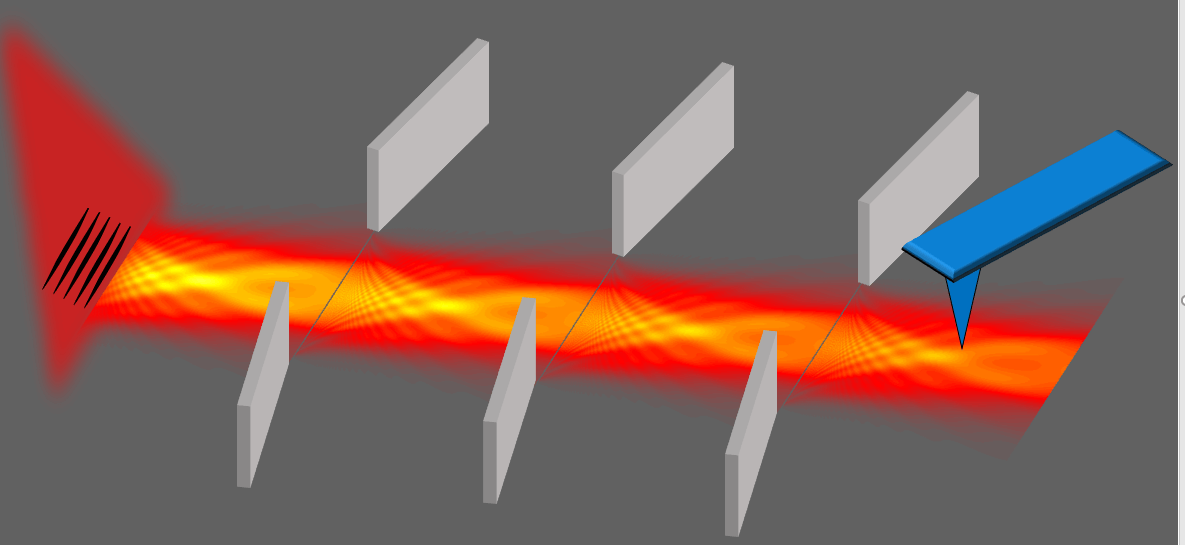The system will enable transmission of electromagnetic waves in the x-ray and terahertz fields

New research by Tel Aviv University has led to the development of a new and efficient waveguide, based on fundamental principles in physics, and which will allow waveguides to be used that until now have been difficult to do so with.
Waveguides appear in a variety of configurations. A well-known example is the stethoscope (mask in Hebrew) which conducts the sound waves from the patient's body to the doctor's ear. For radio waves or microwaves, the familiar configuration of a waveguide is a thin metal tube. For light waves, a more efficient method is to use an optical fiber made of glass, whose refractive index is chosen so that the waves remain trapped inside until they reach the fiber's outlet. However, in some cases it is difficult to find suitable materials that will allow the confinement of the waves. Waveguides are needed because without them the waves will expand and no efficient transfer from one point to another will be possible. For example, waves passing through a crack will usually propagate through space.
The research was conducted under the leadership of doctoral students Dror Weissman from Prof. Adi Aryeh's group from the School of Electrical Engineering and the head of the Marco and Lucy Shaul Nano-Photonics Chair at Tel Aviv University. Doctoral student Geri Georgi Rosenman, Prof. Lev Shemer, as well as researchers from the University of Ulm in Germany - Doctoral student Moritz Kramsin, Dr. Maxim Aframov and Prof. Wolfgang Schleich participated in the study. The research was recently published in the prestigious journal Physical Review Letters.
A series of cracks
New experiments with plasmonic waves (a combination of light and electronic oscillations) and with surface gravity waves moving over water, show that a sequence of cracks is able to conduct the waves in a narrow path. The cracks block the outer edges of the waves, while the unblocked waves are concentrated along a central axis of the waveguide as a result of the interference. This simple system, based on cracks, can be useful in situations where it is difficult to produce conventional waveguides, for example for electromagnetic waves in the X-ray or terahertz range. results
Wiseman and his partners succeeded in developing a waveguide based on cracks. "We don't need any special material with a certain refractive index," says Wiseman. "The only thing we need is a substance that blocks the advance of the waves."
The idea is based on a phenomenon called "diffractive focusing", in which the intensity of the waves passing through a crack increases before the beam diverges. This focusing is usually difficult to notice because it happens close to the crack: for a crack about five wavelengths wide, the focusing occurs at a point located only about eight wavelengths from the crack.
In a previous study dealing with indirect focusing, Wiseman and his collaborators measured waves advancing through two cracks in succession, with the second crack located near the focus of the first crack. They observed that when light passed through both slits together, the diffraction pattern was similar to that obtained from a single slit - that is, it is possible to repeat the process with a third slit, a fourth, and so on. The team predicted that each crack could focus the signal before reaching the next crack, thus effectively creating a waveguide.
Validation using two experiments
The researchers have now verified their prediction using two experiments. The first was based on plasmonic waves - electromagnetic waves that move across a metal surface and are coupled to the electrons in it. In order to create a crack-based plasmonic waveguide on a silver plate, the team created pairs of nanometer-thin silver walls that the plasmonic wave can travel between. Next, they excited the structure with a laser beam and measured the intensity distribution using an optical microscope that scans the intensity of the plasmonic wave in the near field. They estimated that each crack causes a loss of about 10% of the energy of the laser beam, due to the truncation of the ends of the wave by the walls. The new waveguide has transmission losses similar to those of existing plasmonic waveguides.
In the second experiment, PhD student Georgi Gerry Rosenman tested the new waveguide using surface gravity waves moving over water, in a unique 18 meter long wave pool, in the laboratory of Prof. Lev Shemer from the School of Mechanical Engineering at Tel Aviv University. In this experiment, the researchers created a wave that propagated through the pool of water and warped it each time in the time plane. The team measured the waveform near the focal point, and fed the information about the wave's strength and phase (instance) back into the wave generator to create the next wave packet, while clipping the information that leaked out of the temporal crack. This repeated operation showed a repeating propagation pattern each time, both in magnitude and phase.
"The new waveguide is a general solution that can be applied to a wide range of waves," says Wiseman. In addition to light waves and water waves, the method can be used for the transmission of sound waves, material waves, and more. Another advantage is that the sizes of the cracks and their positions can be adjusted. For example, the team showed that shrinking the width of the cracks allowed the waveguide to narrow the beam, while moving the positions of the cracks changed the direction of the beam.
More of the topic in Hayadan:
- An observation in Bar-Ilan yielded surprising results in the field of material conductivity
- Popular Science/Capturing the T-rays
- The hitherto untapped terahertz frequencies will enable the remote detection of explosives and camouflaged munitions
- "Surprising results": research reveals for the first time what happens at the end of the crack
